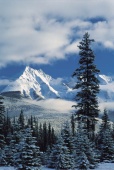
|
|||

|
|||
Kootenay National Park, British Columbia, Canada
|

|
||
The Kootenay National Park was established in 1920 and a result of the first road across the Canadian Rockies. When the Banff-Windermere Highway was build, a strip of land 8km wide on each side was protected as national park. The highway was completed in 1922 and has a length of 94 km, nowadays known as Kootenay Parkway. Many of the park's attractions can be experienced from the Kootenay Parkway (Hwy 93), which is the only road in the park. There is an abundance of wildlife in this park and elk, white-tailed deer, mountain goats and bighorn sheep are often seen along the highway. Not as often, but still inhabitants of this region are black bear, moose, coyotes and wolves. Lucky ones will even see an osprey. Marble Canyon A 30 minute walk brings you to a deep and scenic gorge carved by the waters of Tokumm Creek. The fast running waters carved this canyon out of limestone and parts of it has become marble during the time. The trail follows the rushing Tokumm Creek and leads you over many small wooden bridges to the waterfall. This 2 km long walk is one of the most interesting ones of the park. Paint Pots About 100 years ago, the colorful earth out of these ochre pools, that are nowadays knows as Paint Pots, were collected by the Kootenay people and later by European settlers to use as a coloring agent. Today an easy trail trough the forest brings you to this attraction. These colorful pools are formed by mineral springs. There are many opportunities for hiking enthusiasts within the Kootenay National Park. One classic trail is the 4 hour Stanley Glacier Trail that leads to the Mount Stanley Glacier. Radium Hot Springs Three kilometres northeast of the town of Radium Hot Springs you will find the hot springs to spend a day relaxing. The first recorded visit to the springs were made in 1841 by Sir George Simpson, the governor of the Hudson's Bay Company. Then in 1890 the springs were purchased by Roland Stuart for $160. In 1922 Stuart's property was expropriated and the springs became part of the new national park. Today the springs are a major tourist attraction and become busy especially in summer time. |
|||
|
Back
British Columbia |
|||
